.
Garden Diary - August 2019
If you have any comments, observations, or questions about what you read here, remember you can always Contact Me
All content included on this site such as text, graphics and images is protected by U.S and international copyright law.
The compilation of all content on this site is the exclusive property of the site copyright holder.
August
Plowing Match at the Howell Living History Farm
Saturday, 31 August 2019
The hitches are here for the 36th annual Howell Farm Plowing Match. They come from Hackettstown and Stockton in New Jersey, and Telford, Mt. Bethel, Ronks, Broadheadsville, and New Egypt, Pennsylvania. Powerful pickup trucks pulling large stock trailers with draft horses. As well as Howell Farm's own Belgians and Belgian crosses there are teams of ever popular Percherons and Brabants. This year there are also two teams of mules.
The annual plowing match on Labor Day weekend is significant. It marks the beginning of the ten month long winter wheat crop production cycle. Plowing is but the first step in working up the soil into a seed bed. Today is more of a demonstration as each team is plowing separate "lands" which the Howell farmers will later need to join up. Plowing turns over the soil, loosening it and burying weeds and crop debris. Then the field will be rolled, harrowed in several directions, and leveled with a plank drag. It will be late September before the winter wheat will be sown. Called winter wheat because the seed will germinate before winter, and the young plants will make most of their growth next year, with harvest in July.
 .
.
Once upon a time draft animals were the only option, as on this long ago farm in France.
At Howell, a living history farm that stays in the decades from 1890 to 1910, they also use
heavy horses for draft animals, for plowing, reaping, logging, and other work on the farm.
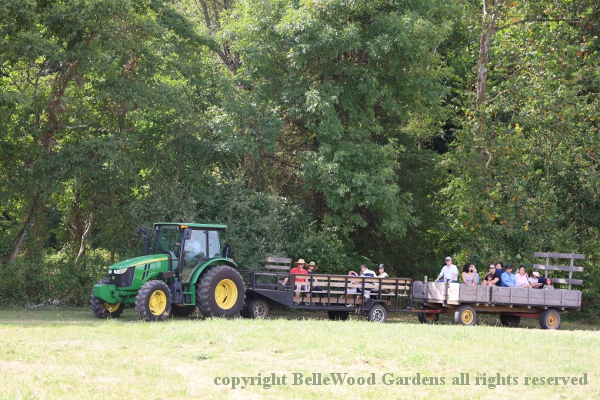
Let's go up to the east crop fields and watch the plowing. It's an easy walk from
the farmhouse up to the fields. Or, if instead you'd rather ride there's a tractor
pulling a couple of wagons. Steps up, with comfortable hay bales on which to sit.

A plowman takes his team and the plow across the field
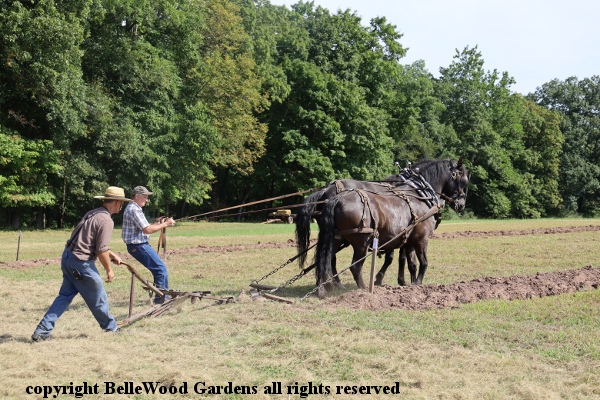
The team is eager to go. Needs one man to steady them and a second
to lift the plow and quickly set the plowshare to penetrate into the soil.

.
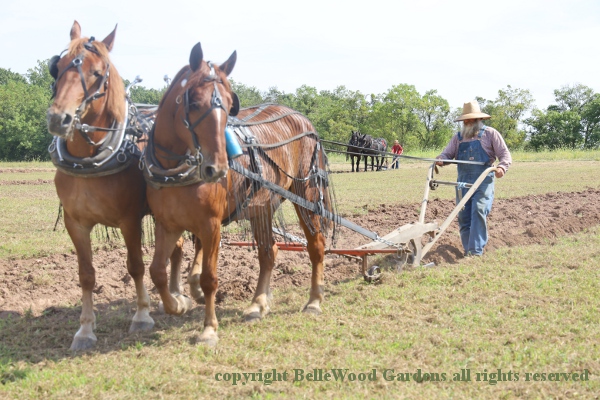
The fringe you can see dangling below the horses are part of a net-like fly sheet.
It fits over the harness, protecting from annoying biting of summertime horse flies.

One of the attributes to be judged for fine plowing is how well does the team pull
together. Do they work evenly or does one pull more than the other. This team . . .
The other horse is lazy, the plow woman told me. And this horse is actually deaf.
Once she figured that out, and learned how to work with him he does a good job.

Jury and Newell, the King family team of mules, are walking across the east crop fields to
the path back down to the road that leads to the round pasture for the mid-day break time.

Kelly Stewart of Mt. Bethel pauses to chat. His mules, Pete and Paul, seem content to wait.
If you are unfamiliar with "what is a mule" they are a cross between a jack, a male donkey, and a mare, a female horse. The mare's size affects that of the mule. I expect draft horse mares were mothers for these large mules. The chromosome count of horses (64) and donkeys (62) means that mules have 63 chromosomes. Mule stallions are always sterile, mare mules are almost always sterile. Mules were valued because they are capable of more work than the same size horse, sure-footed over rough mountainous terrain, and can survive on rough forage, characteristics useful for armies and pack trains. Oh, and that 20 mule team borax we used to see in the stores? That was actually 18 mules and 2 horses, hauling tons of borax ore out of Death Valley for a few years in the late 1800s.

Ella Mae, Jethro, and Kitty, a three horse hitch of Pat Hlubik's Brabants
in their "show" harness. When I saw a Hlubik two horse hitch logging
here at Howell back in November 2015 they wore plain work harness.
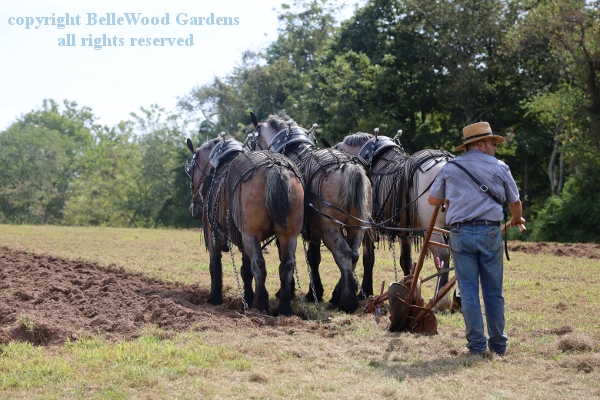
Pat Hlubik and his very well trained team. In 2016, 2017, and 2018 it was
Jethro and Kitty, with Ike, that were the fine plowing competition winners.

One of Howell's three draft horse teams, Belgian Crosses Bill and Jessie.

The fine points of fine plowing are these: are the furrows straight, of uniform width and even depth. Are the ends of each furrow even, the plow having been removed at the same point as the others, not zig-zag and ragged. And the team: are the animals sound, fit, well muscled, with the equipment - harness, yoke, plow and eveners - well maintained, clean, in good condition. Does the team walk at an even, steady pace, responding well to the plowman's voice and driving lines. At a steady pace a good team should be capable of plowing about an acre a day.
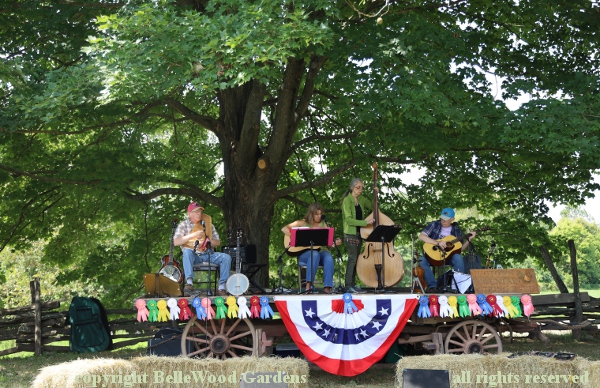
The Jugtown Mountain string band is playing, up by the farmhouse
where food is available for purchase. What's on offer?
Pulled pork sandwich generously piled on a bun for $5.. Barbecue chicken or hot dogs for $3. Sides of baked potato or corn on the cob, sauerkraut, fresh tomato salad. Packages of potato chips, single serving size. Soda, bottled water.

And for dessert there's ice cream in several flavors, churned by
the early 20th century Orr and Sembower hit-and-miss engine.
A wonderful end of a summer day at the Howell Living History Farm.
Back to Top
Back to August 2019
Back to the main Diary Page
 .
.













